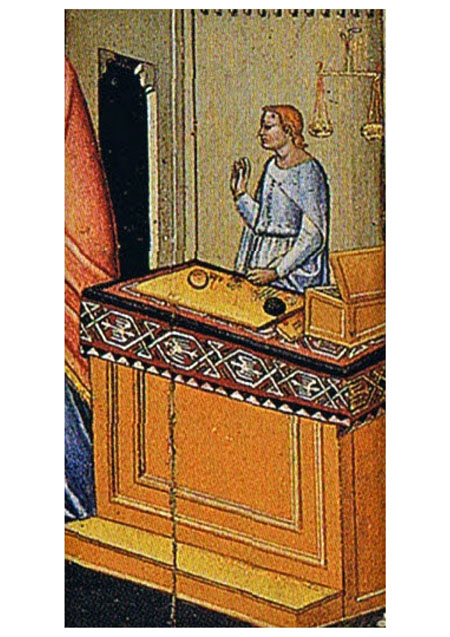Hi Marvin, Filiberto,
We seem to agree that at least some of these rugs were not woven according to pure Islamic canons. An influence of medieval Europe is a possibility and IMHO there is nothing terribly outlandish in Filiberto's hypothesis that Gaddi’s rug, for exemple, could have been woven in Italy.
Orcagna’s rug below (1367, Calling of St Matthew, Uffizi, Florence), while more sophisticated than Gaddi’s rug, could also be suspected of strong European or Byzantine influence, with its heraldic eagles sprayed all over both field and border.

When the first animal rugs appeared in paintings during the 13th century there was no shortage of places were «exchanges of art» between Islam and medieval Europe could have taken place peacefully, in particular Norman and Hohenstaufen Sicily (were symbiosis was much favored by the local Kings), and of course Al Andaluz.
Besides, let’s not forget that at that time a large chunk of Anatolia was still not ruled by Moslems, but by the Latin empire (followed in 1268 by the last phase of the Byzantine empire), the remains of Great Armenia (still including part of Cilicia) and by the byzantine "Empire" of Nicae. The population was still mainly Christian (Greek orthodox, Armenian etc..). Even in Seljuk and Mameluk territory, the authorities had no particular urge for converting the still very large non-Moslem minorities, who contributed a large percentage of the tax money and provided slaves (including soldiers).

Even though several Turkish-, Armenian- and Persian- rug experts and writers have concocted creative theories, trying to make us believe that their favorite ethnic group was the sole inventor of piled rugs (and the weaver of the Pazyryk carpet to boot), there is really no reason to believe that Greek, Coptic or Druze populations, to name just a few, were never involved in carpet weaving.
About the theory that the sophisticated "pregnant animals" rugs were not woven before Ottoman rule, I share Filiberto's scepticism. Just give a look to the border of the Kirchheim rug (main essay). Does it not ring a clear (seljuk) bell?
Best regards
Pierre